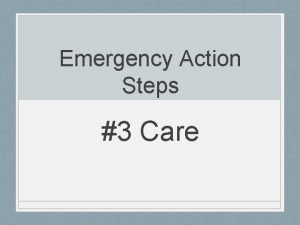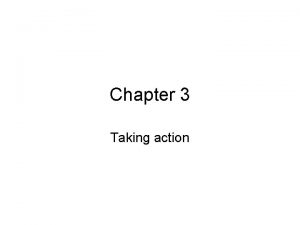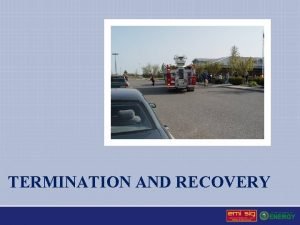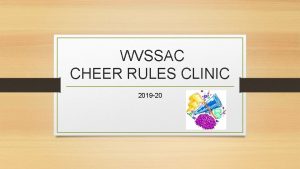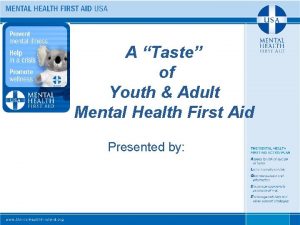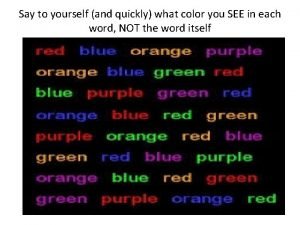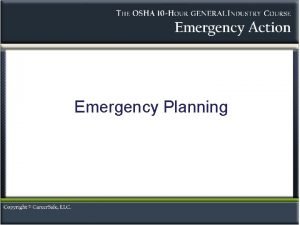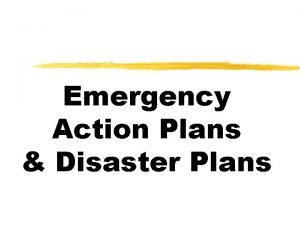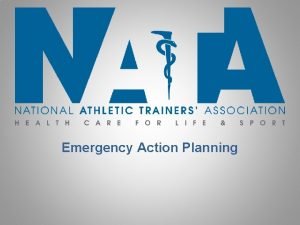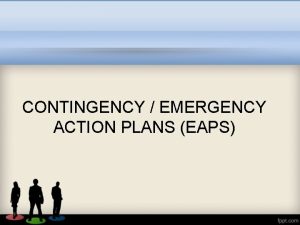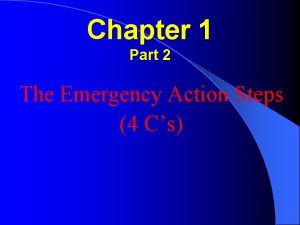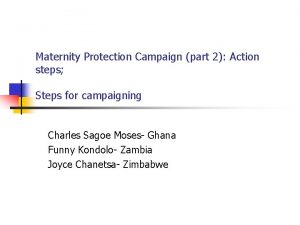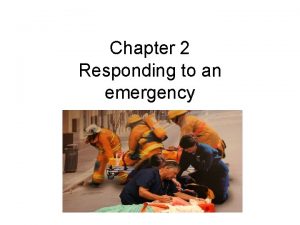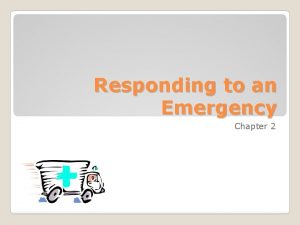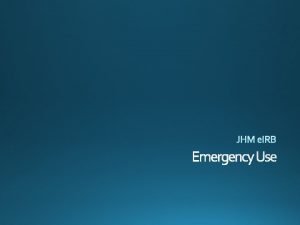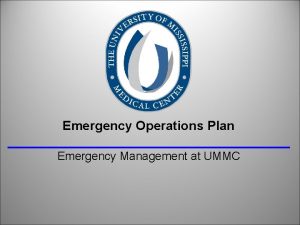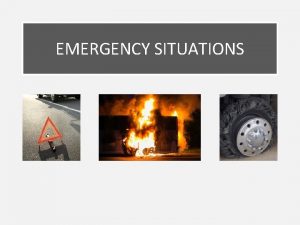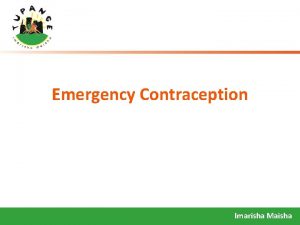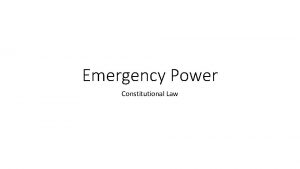Chapter 1 Part 2 The Emergency Action Steps


















- Slides: 18

Chapter 1 Part 2 The Emergency Action Steps (4 C’s)

Chapter 2 Objectives 1. 2. 3. 4. 5. 6. Identify the four emergency action steps. Establish four important questions to be answered when checking the scene of an emergency. Explain what to do if the scene is unsafe. List four conditions considered life threatening in an emergency. Name three things you must tell the victim to get permission to give care. Make clear when and how to call EMS personnel.

Preparing for Emergencies l l l l Keep important information. Keep medical and insurance records. Find out if your community is served by 9 -1 -1 or a local emergency telephone number. Keep emergency telephone numbers listed. Keep a first aid kit readily available. Learn and stay up to date on first aid and cardiopulmonary resuscitation (CPR) skills. Make sure your house or apartment number is easy to read. Wear a medical alert tag.

Taking Action Emergency Action Steps- The four C’s The emergency action steps are the four basic steps you should take in any emergency. These steps include: 1. 2. 3. 4. Stay Calm, you must always keep yourself under control. Check the scene, then Check the victim. Call 9 -1 -1 or the local emergency number. Care for the victim until professional medical help arrives. http: //www. youtube. com/watch? v=Snxf. V 3 i. G 9 i. Q

Check the Scene Before you can help the victim, you must make sure the scene is safe for you and any bystanders. Take time to check the scene and answer these four important questions…

Check the Scene (Continued) 1. Is the scene safe? l Look for anything that may threaten your safety and that of the victim or bystanders. If any dangers are threatening, do not approach the victim. Retreat and call 9 -1 -1 immediately. 2. What happened? l Look around the scene for clues about what caused the emergency and the type and extent of the victim’s injuries. If the victim is unconscious, your check of the scene may be the only way to tell what happened.

Check the Scene (Continued) 3. How many Victims are there? l Look carefully for more than one victim. You may not spot everyone at first. If you find more than one victim ask bystanders to help care for them. 4. Are Bystanders available for help? l Bystanders may be able to tell you what happened or help in other ways. A bystander who knows the victim may know whether he or she has any medical problems or allergies.

Check the Victim l Do not move a victim unless an immediate danger, such as fire, flood, poisonous fumes, hazardous traffic patterns, or unstable structure, threatens you and the victim. l If you find the victim has any immediate lifethreatening conditions, you must call EMS personnel immediately or send someone else to call.

Check the Victim (Continued) The four conditions considered immediately life threatening in an emergency situation are: 1. 2. 3. 4. unconsciousness no breathing or difficulty breathing no pulse severe bleeding

Check the Victim (Continued) l Be calm and reassuring l Before giving first aid to a conscious adult victim, identify yourself as a person trained in first aid. l Get permission to provide care. This permission is referred as consent. To get consent you must tell the victim: 1. 2. 3. l Who you are Your level of training What it is you would like to do. If the victim is unconscious or unable to respond consent is implied. http: //www. instructorscorner. org/media/videos/a 3. html

Call EMS Personnel Your top priority as a citizen responder is to get professional help to the victim as soon as possible. The system works more effectively if you can provide information about the victim’s condition when the call is placed. This information helps to ensure that the victim receives proper medical care as quickly as possible.

When to call As general rule, call EMS personnel for any of the following conditions: l l l Unconscious or altered level of consciousness Breathing problems Persistent chest or abdominal pain or pressure No pulse Severe bleeding Severe burns l l l Vomiting blood or passing blood in feces or urine Poisoning or suspected poisoning Seizures, severe headache, or slurred speech Injuries to head neck, or back Broken bones or suspected broken bones

When to call Special situations l Fire or explosion. l The presence of poisonous gas. l Downed electrical wires. l Motor vehicle collisions. l Victims who cannot be moved easily.

Making the Call When you make the call, you should do the following: 1. If someone else is placing the call give them the number. 2. Give necessary information: • The exact street address or location. • The telephone number from which the call is being made. • Your name • What happened • How many people are involved • The condition of the victim • The help be given 3. Do not to hang up until the dispatcher hangs up. 4. If someone else is making the call, tell them to report to you after making the call.

Making the Call When you are alone If you are in a situation in which you are the only person other than the victim, you must make a decision to Call First or Call Fast. You should call first before giving care if: 1. 2. An unconscious adult victim or child age 8 or older. An unconscious infant or child known to be at high risk for heart problems. Call First situations are likely to be cardiac emergencies, such as sudden cardiac arrest, where time is critical.

Making the Call When you are alone Call Fast, that is, provide 1 minute of care, then call 9 -1 -1 for: 1. 2. 3. 4. An unconscious victim younger than 8 Any victim of submersion or near-drowning Any victim of cardiac arrest associated with trauma Any victim of drug overdose. Call Fast situations are likely to be related to breathing emergencies rather than sudden cardiac arrest. In these situations provide support for airway, breathing and circulation through rescue breaths and chest compressions, as appropriate

Care Once you have checked the scene and the victim, you may have to provide care. Always care for life-threatening conditions before those that are not. If the victim is conscious be aware of their condition, just in case it changes. This may be a sign of a more serious illness or injury.

Closure l You, the citizen responder trained in first aid, play a critical role by being the first link in the chain of survival. Your actions can help save a life. l The most important things you can do in any emergency are to recognize that an emergency has occurred and decide to act. l Check – Call –Care will guide your actions in any emergency and most importantly stay Calm l If you are prepared for unforeseen emergencies, you can help ensure that care begins as soon as possible – for yourself, your family, and your fellow citizens. l Your training will help you better mange your fears and overcome barriers to action and enable you to respond more effectively. http: //www. instructorscorner. org/media/videos/j 4. html
 3 emergency action steps
3 emergency action steps The emergency action steps are:
The emergency action steps are: What are the emergency action steps
What are the emergency action steps Emergency action plan swimming pool
Emergency action plan swimming pool Drowning emergency action plan
Drowning emergency action plan Emergency action termination
Emergency action termination Wvssac rosters
Wvssac rosters Different axial and locomotor movements
Different axial and locomotor movements Community action plan
Community action plan Steps of an action potential
Steps of an action potential Algee action plan?
Algee action plan? Steps of action potential
Steps of action potential Hình ảnh bộ gõ cơ thể búng tay
Hình ảnh bộ gõ cơ thể búng tay Slidetodoc
Slidetodoc Bổ thể
Bổ thể Tỉ lệ cơ thể trẻ em
Tỉ lệ cơ thể trẻ em Chó sói
Chó sói Chụp tư thế worms-breton
Chụp tư thế worms-breton Chúa yêu trần thế alleluia
Chúa yêu trần thế alleluia
